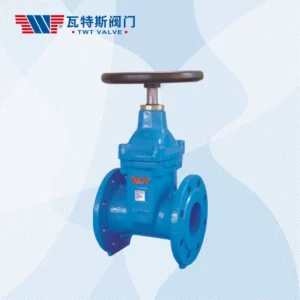DIN 3202 F4 and F5 gate valves are typically constructed using a variety of materials to suit different applications and environmental conditions. The choice of materials depends on factors such as the type of fluid being handled, pressure requirements, temperature, and corrosion resistance.
Common materials used in the construction of these gate valves include:
- Cast Iron: Cast iron gate valves are a popular choice for general industrial applications. They are durable and cost-effective.
- Ductile Iron: Ductile iron gate valves are known for their strength and durability, making them suitable for high-pressure and high-temperature applications.
- Carbon Steel: Carbon steel gate valves are commonly used in applications where resistance to high pressure and temperature is required. They are also used in applications involving non-corrosive fluids.
- Stainless Steel: Stainless steel gate valves are used when corrosion resistance is a priority, particularly in industries dealing with corrosive or chemical fluids.
- Bronze: Bronze gate valves are often used for marine and seawater applications due to their excellent corrosion resistance properties.
- Brass: Brass gate valves are used for water and air applications and offer good corrosion resistance and ease of maintenance.
- Alloy Steel: Alloy steel gate valves are chosen for applications requiring high strength and resistance to high temperatures and pressures.
- Forged Steel: Forged steel gate valves are used in high-pressure and high-temperature applications and are known for their strength and reliability.
- Nickel-Alloy: Nickel-alloy gate valves are selected for extremely corrosive environments, such as in the chemical and petrochemical industries.
The specific material chosen for a DIN 3202 F4 or F5 gate valve will depend on the intended use and the properties required to ensure the valve’s performance and longevity in that particular application. din3202f4&f5 gate valve It’s important to consult the manufacturer’s specifications and guidelines to select the appropriate material for a given application.
How does the pressure rating of DIN 3202 F4 and F5 gate valves differ?
The pressure ratings of DIN 3202 F4 and F5 gate valves differ based on their design and construction. These pressure ratings indicate the maximum allowable pressure at which the valves can safely operate. Here’s how the pressure ratings of DIN 3202 F4 and F5 gate valves typically differ:
- DIN 3202 F4 Gate Valve:
- DIN 3202 F4 gate valves are designed for lower-pressure applications.
- They are typically suitable for operating pressures up to PN16 (16 bar or approximately 232 psi).
- F4 gate valves are commonly used in applications where lower to moderate pressure handling is required.
- DIN 3202 F5 Gate Valve:
- DIN 3202 F5 gate valves are designed to handle higher pressure conditions.
- They typically have higher pressure ratings, such as PN25 (25 bar or approximately 363 psi) or even higher, depending on the specific design and manufacturer.
- F5 gate valves are used in applications where higher pressure requirements are necessary.
It’s important to note that the actual pressure rating of a gate valve can vary based on factors such as the materials used, the design and manufacturing standards, and the specific manufacturer’s specifications. Therefore, it’s crucial to consult the manufacturer’s documentation and product data sheets to determine the precise pressure rating of a DIN 3202 F4 or F5 gate valve for a particular application. Choosing the right pressure rating is essential to ensure the safe and efficient operation of the valve in a given system.
